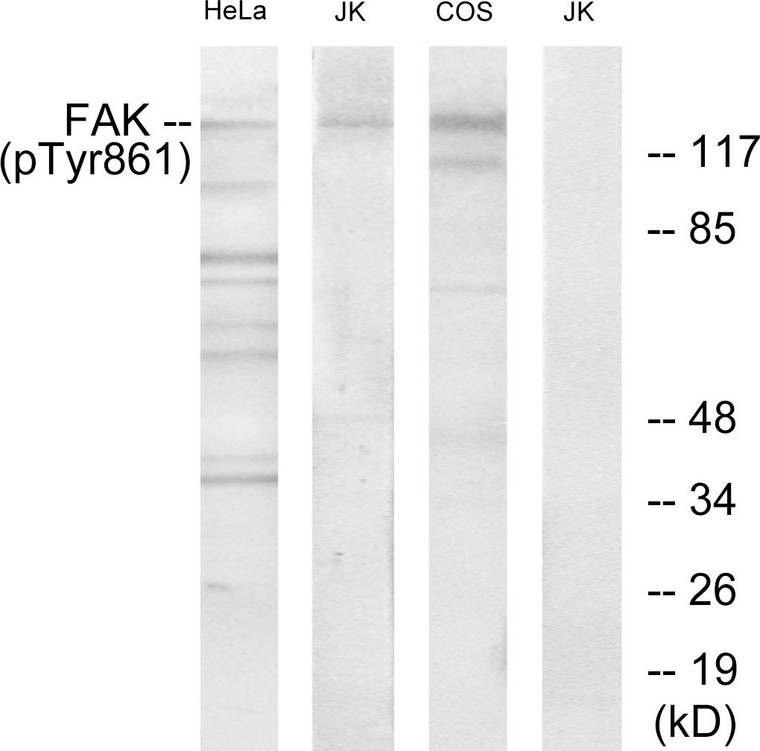| Host: |
Rabbit |
| Applications: |
WB/ELISA |
| Reactivity: |
Human/Mouse/Rat/Monkey |
| Note: |
STRICTLY FOR FURTHER SCIENTIFIC RESEARCH USE ONLY (RUO). MUST NOT TO BE USED IN DIAGNOSTIC OR THERAPEUTIC APPLICATIONS. |
| Short Description: |
Rabbit polyclonal antibody anti-Phospho-Focal adhesion kinase 1-Tyr861 (828-877 aa) is suitable for use in Western Blot and ELISA research applications. |
| Clonality: |
Polyclonal |
| Conjugation: |
Unconjugated |
| Isotype: |
IgG |
| Formulation: |
Liquid in PBS containing 50% Glycerol, 0.5% BSA and 0.02% Sodium Azide. |
| Purification: |
The antibody was affinity-purified from rabbit antiserum by affinity-chromatography using epitope-specific immunogen. |
| Concentration: |
1 mg/mL |
| Dilution Range: |
WB 1:500-1:2000ELISA 1:20000 |
| Storage Instruction: |
Store at-20°C for up to 1 year from the date of receipt, and avoid repeat freeze-thaw cycles. |
| Gene Symbol: |
PTK2 |
| Gene ID: |
5747 |
| Uniprot ID: |
FAK1_HUMAN |
| Immunogen Region: |
828-877 aa |
| Specificity: |
Phospho-FAK (Y861) Polyclonal Antibody detects endogenous levels of FAK protein only when phosphorylated at Y861. |
| Immunogen: |
The antiserum was produced against synthesized peptide derived from the human FAK around the phosphorylation site of Tyr861 at the amino acid range 828-877 |
| Post Translational Modifications | Phosphorylated on tyrosine residues upon activation, e.g. upon integrin signaling. Tyr-397 is the major autophosphorylation site, but other kinases can also phosphorylate this residue. Phosphorylation at Tyr-397 promotes interaction with SRC and SRC family members, leading to phosphorylation at Tyr-576, Tyr-577 and at additional tyrosine residues. FGR promotes phosphorylation at Tyr-397 and Tyr-576. FER promotes phosphorylation at Tyr-577, Tyr-861 and Tyr-925, even when cells are not adherent. Tyr-397, Tyr-576 and Ser-722 are phosphorylated only when cells are adherent. Phosphorylation at Tyr-397 is important for interaction with BMX, PIK3R1 and SHC1. Phosphorylation at Tyr-925 is important for interaction with GRB2. Dephosphorylated by PTPN11.PTPN11 is recruited to PTK2 via EPHA2 (tyrosine phosphorylated). Microtubule-induced dephosphorylation at Tyr-397 is crucial for the induction of focal adhesion disassembly.this dephosphorylation could be catalyzed by PTPN11 and regulated by ZFYVE21. Phosphorylation on tyrosine residues is enhanced by NTN1. Sumoylated.this enhances autophosphorylation. |
| Function | Non-receptor protein-tyrosine kinase that plays an essential role in regulating cell migration, adhesion, spreading, reorganization of the actin cytoskeleton, formation and disassembly of focal adhesions and cell protrusions, cell cycle progression, cell proliferation and apoptosis. Required for early embryonic development and placenta development. Required for embryonic angiogenesis, normal cardiomyocyte migration and proliferation, and normal heart development. Regulates axon growth and neuronal cell migration, axon branching and synapse formation.required for normal development of the nervous system. Plays a role in osteogenesis and differentiation of osteoblasts. Functions in integrin signal transduction, but also in signaling downstream of numerous growth factor receptors, G-protein coupled receptors (GPCR), EPHA2, netrin receptors and LDL receptors. Forms multisubunit signaling complexes with SRC and SRC family members upon activation.this leads to the phosphorylation of additional tyrosine residues, creating binding sites for scaffold proteins, effectors and substrates. Regulates numerous signaling pathways. Promotes activation of phosphatidylinositol 3-kinase and the AKT1 signaling cascade. Promotes activation of MAPK1/ERK2, MAPK3/ERK1 and the MAP kinase signaling cascade. Promotes localized and transient activation of guanine nucleotide exchange factors (GEFs) and GTPase-activating proteins (GAPs), and thereby modulates the activity of Rho family GTPases. Signaling via CAS family members mediates activation of RAC1. Phosphorylates NEDD9 following integrin stimulation. Recruits the ubiquitin ligase MDM2 to P53/TP53 in the nucleus, and thereby regulates P53/TP53 activity, P53/TP53 ubiquitination and proteasomal degradation. Phosphorylates SRC.this increases SRC kinase activity. Phosphorylates ACTN1, ARHGEF7, GRB7, RET and WASL. Promotes phosphorylation of PXN and STAT1.most likely PXN and STAT1 are phosphorylated by a SRC family kinase that is recruited to autophosphorylated PTK2/FAK1, rather than by PTK2/FAK1 itself. Promotes phosphorylation of BCAR1.GIT2 and SHC1.this requires both SRC and PTK2/FAK1. Promotes phosphorylation of BMX and PIK3R1. Isoform 6 (FRNK) does not contain a kinase domain and inhibits PTK2/FAK1 phosphorylation and signaling. Its enhanced expression can attenuate the nuclear accumulation of LPXN and limit its ability to enhance serum response factor (SRF)-dependent gene transcription. Isoform 6: Isoform 6 (FRNK) does not contain a kinase domain and inhibits PTK2/FAK1 phosphorylation and signaling. Its enhanced expression can attenuate the nuclear accumulation of LPXN and limit its ability to enhance serum response factor (SRF)-dependent gene transcription. |
| Protein Name | Focal Adhesion Kinase 1Fadk 1Focal Adhesion Kinase-Related NonkinaseFrnkProtein Phosphatase 1 Regulatory Subunit 71Ppp1r71Protein-Tyrosine Kinase 2P125fakPp125fak |
| Database Links | Reactome: R-HSA-111465Reactome: R-HSA-2029482Reactome: R-HSA-354192Reactome: R-HSA-354194Reactome: R-HSA-372708Reactome: R-HSA-375165Reactome: R-HSA-391160Reactome: R-HSA-3928662Reactome: R-HSA-418885Reactome: R-HSA-4420097Reactome: R-HSA-5663213Reactome: R-HSA-5673001Reactome: R-HSA-8874081Reactome: R-HSA-9009391Reactome: R-HSA-9634638Reactome: R-HSA-9664422 |
| Cellular Localisation | Cell JunctionFocal AdhesionCell MembranePeripheral Membrane ProteinCytoplasmic SideCytoplasmPerinuclear RegionCell CortexCytoskeletonMicrotubule Organizing CenterCentrosomeNucleusCilium Basal BodyConstituent Of Focal AdhesionsDetected At Microtubules |
| Alternative Antibody Names | Anti-Focal Adhesion Kinase 1 antibodyAnti-Fadk 1 antibodyAnti-Focal Adhesion Kinase-Related Nonkinase antibodyAnti-Frnk antibodyAnti-Protein Phosphatase 1 Regulatory Subunit 71 antibodyAnti-Ppp1r71 antibodyAnti-Protein-Tyrosine Kinase 2 antibodyAnti-P125fak antibodyAnti-Pp125fak antibodyAnti-PTK2 antibodyAnti-FAK antibodyAnti-FAK1 antibody |
Information sourced from Uniprot.org
12 months for antibodies. 6 months for ELISA Kits. Please see website T&Cs for further guidance









